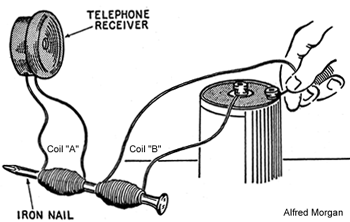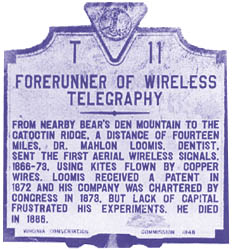
phone
cards
all you need to know about
 |
|
phone | |
all you need to know about | |||
Mobile Telephone History
Page 2 >>
Wireless by Conduction On October 18, 1842, Morse laid wires between Governor's Island and Castle Garden, New York, a distance of about a mile. [For a complete description click here] Part of that circuit was under water, indeed, Morse wanted to show that an underwater cable could transmit signals as well as a copper wire suspended on poles. But before he could complete this demonstration a passing ship pulled up his cable, ending, it seemed, his experiment. Undaunted, Morse proceeded without the cable, passing his telegraph signals through the water itself. This is wireless by conduction.  Over the next thirty years most inventors and developers concentrated on wireline telegraphy, that is, conventional telegraphy carried over wires suspended on poles. Few tinkered exclusively with wireless since basic radio theory had not yet been worked out and trial and error experimenting produced no consistent results. Telegraphy did produce a good understanding of wireless by induction, however, since wires ran parallel to each other and often induced rogue currents into other lines. University research and some field work did continue, though, with many people making contributions. Early Electromagnetic Research In 1843 Faraday began intensive research into whether space could conduct electricity. In April,1846 he reported his findings in a speech called "Thoughts on Ray-vibrations." He continued work in this area for many years, with inventors and academicians closely following his discoveries and theories. James Clerk Maxwell, whom we today would call a theoretical physicist, pondered constantly over Faraday's findings, translating and interpreting these field results into a set of mathematical equations. Maxwell often wove these equations into the many papers he published on electricity and magnetism. Scientists knew that light was a wave but they didn't know what made it up. Maxwell figured it out. In 1864 Maxwell released his paper "Dynamical Theory of the Electromagnetic Field" which concluded that light, electricity, and magnetism, were all related, all worked hand in hand, and that these electromagnetic phenomena all traveled in waves. As he put it "[W]e have strong reason to conclude that light itself -- including radiant heat, and other radiations if any -- is an electromagnetic disturbance in the form of waves . . ." Maxwell found further. If electricity rapidly varied in amount then electromagnetic waves could be produced at will; they would radiate in waves to a distant point. At least he said so. There was no method yet to prove that "other radiations" existed, to demonstrate that waves other than light occurred. How could one see, produce, or detect an invisible wave? Visible light is only one small part of the omnipresent electromagnetic field or spectrum, that great, universal energy force that constantly washes over and through us. (Illustration, 244K) All matter is in fact a wave (internal link) Radio waves as well as infrared waves lie below the visible spectrum. Things like X-Rays lie above. And because light is a radiated electromagnetic emission, lasers and all things optical qualify, strictly speaking, as a radio transmission. Maxwell's equations also stated that radiation increased dramatically with frequency, that is, many more radio waves are generated at high frequencies than low, given the same amount of power. Experimenting with generating high frequency waves thus began. This wasn't an easy task since it isn't until 90,000 cycles per second, or 9kHz, that radio begins. The familiar A.M. radio band starts around 560 kHz, or 560,000 cycles a second, with all present day radio-telephone services far, far above this. If you want to define radio, generating a rapidly oscillating, high frequency electromagnetic wave is certainly a prerequisite.  Let's review before we look at how early radio developers developed high frequency waves. At the top of this page we saw how Morse used conduction, to wirelessly pass a signal without using the atmosphere. The second way is to do wireless is by induction, where one wire induces current to flow in another. The third way is radiation, where high frequency, rapidly moving waves get generated by electricity and radiate from a fixed point like an antenna. I want to cover induction just a bit more, to better let us understand the difference between this method and what we now know as true radio.  Wireless by Induction We can define radio as the transmission and reception of signals by means of high frequency electrical waves without a connecting wire. And as we noted before, true radio requires that a signal modulate a carrier wave. Early induction schemes operated at low frequencies and possessed no modulating signal. As I stated above induction was well known to telegraphy, since signals often jumped from one line to another. This same tendency is known as "cross talk" in telephone lines, where one conversation may be heard on another line. In this case the wires are not physically crossed with each other, rather, induction induces one signal to travel on the wire of a nearby line.  Induction and The Risky Dr. Loomis In 1865 the dentist Dr. Mahlon Loomis of Virginia may have been the first person to communicate wirelessly through the atmosphere. Between 1866 and 1873 he transmitted telegraphic messages a distance of 18 miles between the tops of Cohocton Mountain and Beorse Deer Mountain, Virginia. Perhaps taking inspiration from Benjamin Franklin, at one location he flew a metal framed kite on a metal wire. He attached a telegraph key to the kite wire and sent signals from it. At another location a similar kite picked up these signals and noted them with a galvanometer. No attempt was made to generate high frequency, rapidly oscillating waves, rather, signals were simply electrical discharges, with current turned off and on to represent the dots and dashes of Morse code. He was granted U.S. patent number 129,971 on July 30, 1872 for an "Improvement in Telegraphing," but for financial reasons did not proceed further with his system. 
|